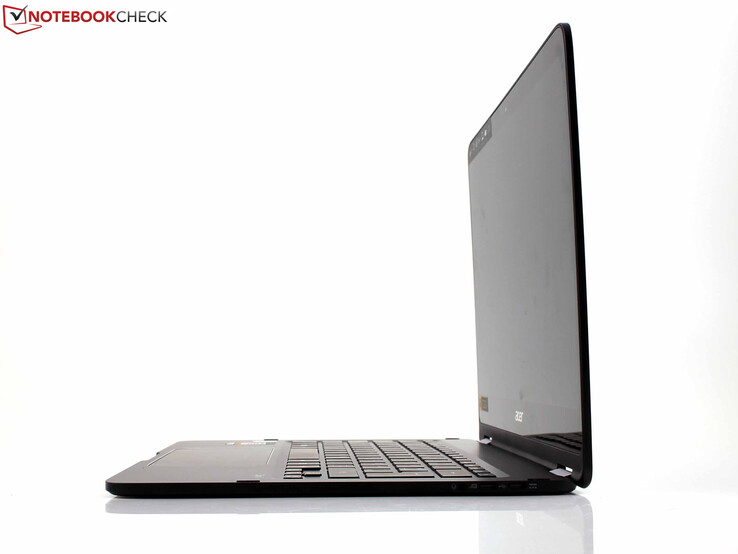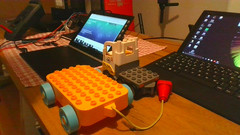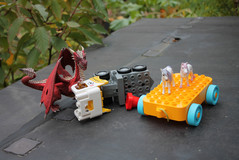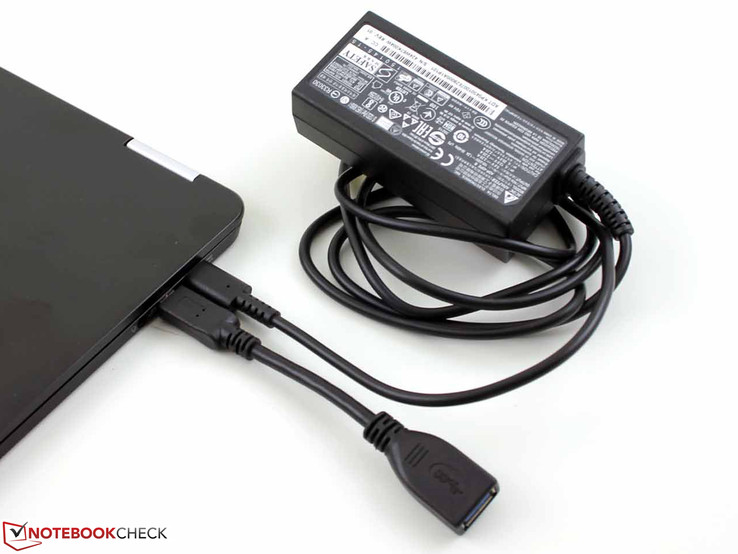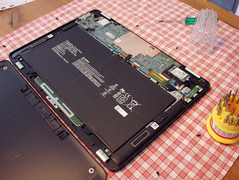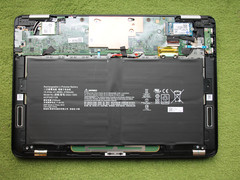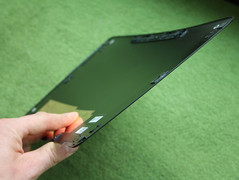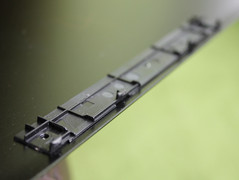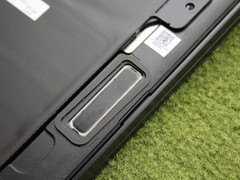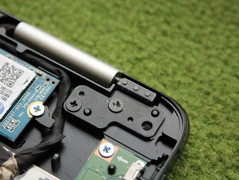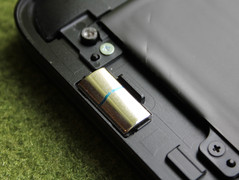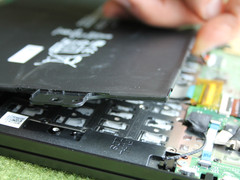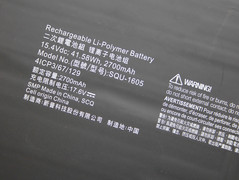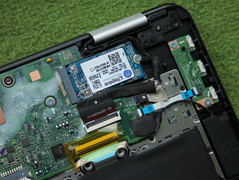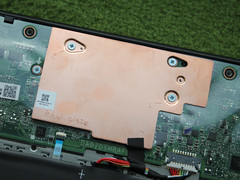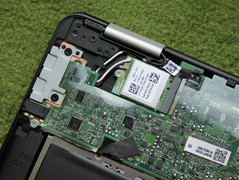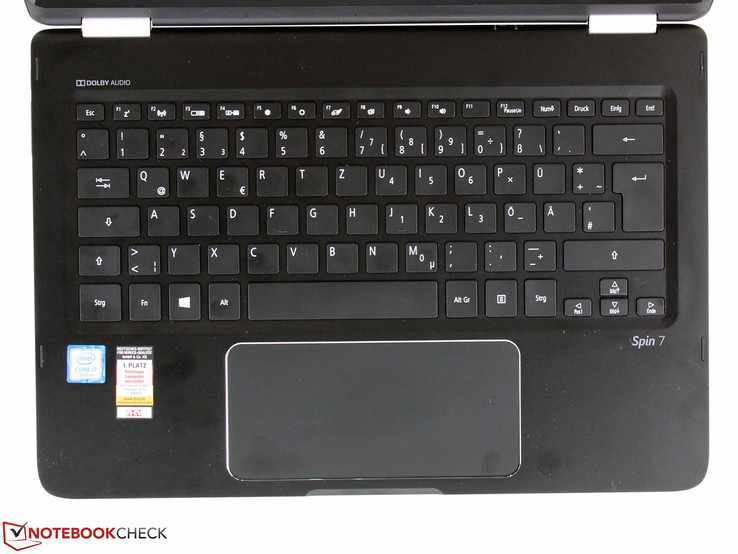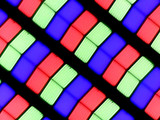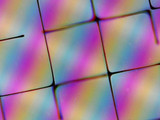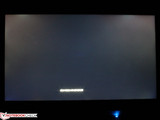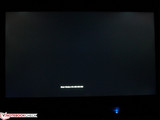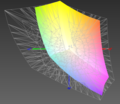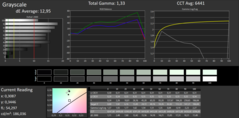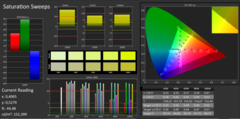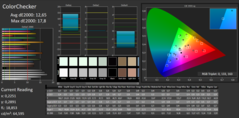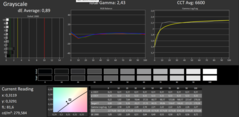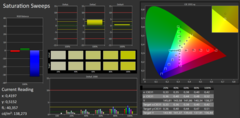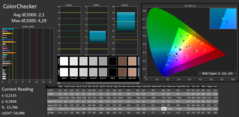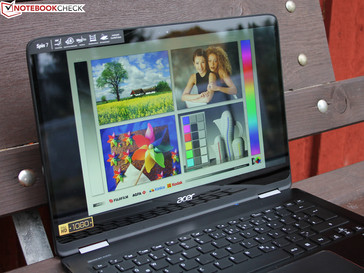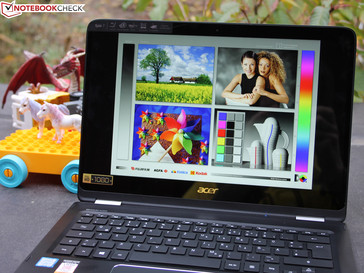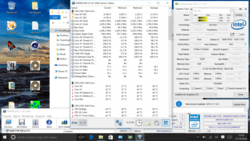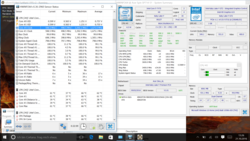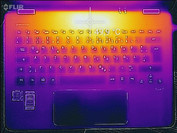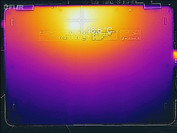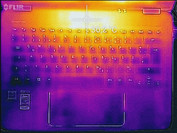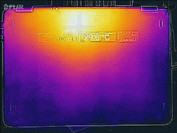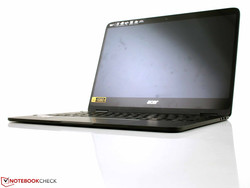Acer Spin 7 SP714-51-M09D Convertible Review

For the original German review, see here.
Acer not only waives the old designation "Aspire" with the new Spin 7 but the storage solutions with optional HDD/SSDs are gone as well. A 2.5-inch drive simply does not fit inside the base unit anymore, which is just 6 millimeters thin. The Spin series is supposed to become Acer's poster child – the manufacturer wants to show what is possible in terms of mobility.
Dell already did it and Acer now puts a 14-inch display into a 13-inch chassis as well. The bezels on the left and right sides of the screen are only 7 millimeters wide. We have a close look at the system and find out whether the new Acer Spin 7 can convince with other things than just the large display.
The competition does not have to hide with their 360-degree convertibles, either. The recently reviewed HP Spectre x360 13 managed a total score of 85%. High-quality input devices and the long battery runtimes impressed the reviewers. The next option for convertible fans is the Asus ZenBook UX360UA-C4159T, which is equipped with a standard 15-Watt processor similar to the HP. We did not like the wobbly display hinges in the review. Asus has now acknowledged there are issues for some batches, but they are not supposed to affect all devices.
Lenovo's ThinkPad X1 Yoga -20FRS1VS00 is more expensive and is primarily targeting demanding business users with more connectivity options, higher resolutions and excellent input devices. It is also equipped with a regular 15-Watt processor, which is the case for the Acer Aspire Switch Alpha 12 SA5-271-56HM as well. The latter is a tablet with an attachable docking keyboard to improve productivity. It does not have a fan, but it does have a 15-Watt SoC with liquid cooling. We also included the Lenovo Miix 510 Pro 80U10006GE in the comparison, which is currently in review as well. Being a 12.2-inch device with docking keyboard, the Miix 510 is certainly an option if you are looking for a 2-in-1 device that replaces your typical laptop.
Case
Acer uses an aluminum-magnesium chassis, which consists of one top cover and a corresponding bottom piece or the TFT panel, respectively. The smooth and rather slippery surface is painted and easily collects fingerprints. The stability of the construction is good, but it is not very good. The lid is solid, and you can only dent it in the center. The base unit on the other hand struggles if you try to lift the open device at one corner, and we can notice some twisting. We do not think this will be a problem for the durability, but it does affect the subjective quality impression. Unfortunate: The bottom cover is very thin and you can clearly feel the hollow space underneath it at some spots.
The hinges are not quite as solid as the aluminum cover suggests, but they are still firm enough to keep the lid in position and the position will not change when there are some vibrations. The latter was a problem of the Asus ZenBook UX360UA. The closed lid is kept in place by magnets, but the connection is not very strong, so the lid will open by itself. This means you can also slightly open it with a finger, but then need the second hand to really open the display.
This magnetic connection is even more important in the tablet mode. Many bigger 360-degree convertibles have problems with their "strange" tablet construction. What we hold in the hand after we fold the display back for the tablet mode is often bulky, has a (deactivated) keyboard at the back and there is an inconvenient gap between the two halves. The Spin 7 does have such a gap as well, but it is pretty small and even. The magnetic force is powerful enough to avoid an unwanted opening, but it could be even stronger for our taste. The fact that the TFT protrudes a bit from the base is a bit strange; the display stands out by 5 millimeters in tablet mode.
The Spin 7 is about 11 millimeters thin and 1271 grams heavy, so the slightly boxy power adapter with a weight of 293 grams (including cable) and a height of 26 mm appears pretty bulky in comparison. The 12.2-inch Spectre x360 13-w023dx is a bit narrower but not as thin as our Spin 7. Lenovo’s ThinkPad X1 Yoga has no problems surrendering the crown for the thinnest device and includes a keyboard with more travel in return. Asus’ ZenBook UX360UA is also thicker because it requires more space for the active cooling solution of the 15-Watt chip.
Connectivity
The two USB Type-C ports can be used for other devices, USB drives and the like, and also for the charging cable. A slot for a Kensington lock is not available, but you could at least use a thin steel cable in combination with the lug.
Communication
Wireless communications are handled by the Atheros/Qualcomm QCA6174, which supports Bluetooth 4.1 as well. Our test with iperf determines almost 600 Mbps under ideal conditions (1 meter from the router, no other active devices, server at LAN). Our comparison shows that this is a very good result.
The Atheros/Qualcomm QCA6174 (a/b/g/n/ac) is a low-profile PCIe-adapter with a MIMO 2x2:2 configuration (2 antennas) as well as Bluetooth 4.1. Low-power PCIe is optimized for lower power consumption, so Acer is happy to waive Wireless Display, which would have been available with an Intel WLAN module.
| Networking | |
| iperf Server (receive) TCP 1 m | |
| Apple MacBook Pro Retina 13 inch 2013-10 | |
| Lenovo Miix 510 Pro 80U10006GE (jseb) | |
| Asus Zenbook UX330UA-FC059T | |
| Asus Zenbook UX360UA-C4159T | |
| Acer Spin 7 SP714-51-M09D (jseb) | |
| Medion Akoya S3409-MD60234 (jseb) | |
| HP ProBook 655 G2 T9X09ET (jseb) | |
| iperf Client (transmit) TCP 1 m | |
| Acer Spin 7 SP714-51-M09D (jseb) | |
| Asus Zenbook UX360UA-C4159T | |
| Apple MacBook Pro Retina 13 inch 2013-10 (Hinum) | |
| Lenovo Miix 510 Pro 80U10006GE (jseb) | |
| Medion Akoya S3409-MD60234 (jseb) | |
| Asus Zenbook UX330UA-FC059T (jseb) | |
| HP ProBook 655 G2 T9X09ET (jseb) | |
Webcam
The webcam produces pixelated images with unnatural colors and washed-out surfaces. A webcam might not have the highest priority for the design process, but the module here is basically unusable.
Accessories
Maintenance
The Spin 7 does not have a maintenance hatch, but it has a bottom panel that is pretty easy to remove. You just have to loosen the Philips screws before you can lift the panel. There are no clips that have to be shifted with a sharp object. Very good! The internals are visible in the following pictures.
Warranty
Acer grants a two-year manufacturer's warranty (Pickup & Return) but also sells more options. An extension to three years retails for 60 Euros (~$66), even though it is for Aspire notebooks. We did not find a special option for the Spin.
Please see our Guarantees, Return Policies & Warranties FAQ for country-specific information.
Input Devices
Keyboard
The stroke hits a sturdy keyboard mat, but the firm pressure point is affected by the shallow key travel. The result is a very poor feedback during typing. Still, it is possible to type quickly on the keys. They do not have a conical curvature, but at least the spacing is sufficient, so 10-finger typists will get used to the input pretty quickly. The keys are not illuminated.
In favor of an ultra-thin base unit, the user has to waive a decent keyboard feedback. This is unfortunate, but probably not avoidable and still better than a keyboard without any key travel and only with force feedback (Lenovo Yoga Book). The input of the Apple MacBook 12 (Butterfly Switch) has an even shallower travel.
Touchpad
The ClickPad has a pretty generous size of 14 x 6.5 centimeters, which results in a diagonal size of 15 centimeters. 14-inch systems often have a diagonal size of just 11 centimeters. The surface is pretty smooth and hardly creates any friction. The fingers can glide very easily, quietly and reliably as a result. Inputs are also recognized towards the edges and the pad sits a bit lower in the palm rest. Because of the similar surface, you could mix them up in theory, but it should not be a big issue considering the width of the pad.
Unsurprisingly, the ClickPad does not have a lot of travel, but it still provides a better feedback than the keyboard in general. At least in the lower third, since the travel gets very shallow towards the top, so mechanical clicks would require a lot of force. You can immediately feel the pressure point, which ends in a firm, but not hard stroke. High pressure can bend the palm rest a bit on solid ground, but this should not be a common problem in practice.
Touchscreen
The touch panel works very well. It is sensitive up into the peripheral areas, pretty smooth and you can only see greasy spots with wet/greasy fingers.
Display
The 14-inch screen with an aspect ratio of 16:9 has a native resolution of 1920x1080 pixels, which results in 157 PPI. The AUO B140HAN03 is a touch panel, but it can only be operated with the finger and not with passive stylus pens. Full HD turned out to be a solid basis for subnotebooks as well as convertibles and meets the requirements for this price range. More pixels are offered by the Lenovo ThinkPad X1 Yoga, which is also available with an OLED version (2560x1440p) besides the IPS panels. All the other rivals are equipped with Full HD IPS screens as well.
We are pretty convinced by the luminance of the crisp panel: 344 nits in the center, and only a minor drop to 332 nits on battery power. The brightness unfortunately drops quite a lot towards the sides, so the average luminance is 292 nits, which is still a good result. The brightness distribution on the other hand is just at 72%, which is the worst result in our comparison group. Thanks to a brightness sensor, the Spin 7 can adjust the luminance automatically, but it can be deactivated by the user.
A contrast ratio of 1323:1 is very high, and only the ZenBook UX360UA can keep up. It also has a similarly low black value but a higher and more even brightness distribution.
We cannot determine any PWM flickering for the screen, but the response times are pretty slow. This is not a deal breaker though, since the Spin 7 will rarely be used as a gaming machine for fast first-person shooters in practice. Another restriction is the iGPU, but we will have a closer look at the performance further below.
| |||||||||||||||||||||||||
Brightness Distribution: 72 %
Center on Battery: 332 cd/m²
Contrast: 1323:1 (Black: 0.26 cd/m²)
ΔE ColorChecker Calman: 12.65 | ∀{0.5-29.43 Ø4.78}
ΔE Greyscale Calman: 12.95 | ∀{0.09-98 Ø5}
89% sRGB (Argyll 1.6.3 3D)
58% AdobeRGB 1998 (Argyll 1.6.3 3D)
62.9% AdobeRGB 1998 (Argyll 3D)
89.1% sRGB (Argyll 3D)
61.5% Display P3 (Argyll 3D)
Gamma: 1.33
CCT: 6441 K
| Acer Spin 7 SP714-51-M09D AUO B140HAN03.2 / AUO323D, , 1920x1080, 14" | Asus Zenbook UX360UA-C4159T AU Optronics AOU272D / B133HAN02.7, , 1920x1080, 13.3" | HP Spectre x360 13-w023dx Chi Mei CMN1367, , 1920x1080, 13.3" | Lenovo ThinkPad X1 Yoga-20FRS1VS00 Samsung ATNA40JU01-0, , 2560x1440, 14" | Acer Aspire Switch Alpha 12 SA5-271-56HM Panasonic VVX12T041N00, , 2160x1440, 12" | Lenovo Miix 510 Pro 80U10006GE Unknown, , 1920x1200, 12.2" | |
|---|---|---|---|---|---|---|
| Display | 5% | 4% | 7% | 4% | ||
| Display P3 Coverage (%) | 61.5 | 64.8 5% | 65.4 6% | 65.5 7% | 64.5 5% | |
| sRGB Coverage (%) | 89.1 | 93.1 4% | 90.4 1% | 96.1 8% | 92 3% | |
| AdobeRGB 1998 Coverage (%) | 62.9 | 66 5% | 65.8 5% | 66.9 6% | 65.5 4% | |
| Response Times | 35% | 14% | 97% | 15% | 24% | |
| Response Time Grey 50% / Grey 80% * (ms) | 51 ? | 29 ? 43% | 33.2 ? 35% | 1 ? 98% | 20 ? 61% | 33 ? 35% |
| Response Time Black / White * (ms) | 26 ? | 19 ? 27% | 28 ? -8% | 1 ? 96% | 34 ? -31% | 23 ? 12% |
| PWM Frequency (Hz) | 50 ? | 240 ? | 1000 ? | 125 ? | ||
| Screen | 18% | 10% | 32% | 11% | 6% | |
| Brightness middle (cd/m²) | 344 | 344 0% | 334.6 -3% | 279 -19% | 345 0% | 327 -5% |
| Brightness (cd/m²) | 292 | 326 12% | 319 9% | 277 -5% | 328 12% | 324 11% |
| Brightness Distribution (%) | 72 | 86 19% | 90 25% | 91 26% | 91 26% | 88 22% |
| Black Level * (cd/m²) | 0.26 | 0.27 -4% | 0.336 -29% | 0.38 -46% | 0.35 -35% | |
| Contrast (:1) | 1323 | 1274 -4% | 996 -25% | 908 -31% | 934 -29% | |
| Colorchecker dE 2000 * | 12.65 | 5.53 56% | 6.21 51% | 5.15 59% | 8.4 34% | 6.54 48% |
| Colorchecker dE 2000 max. * | 17.8 | 10.01 44% | 12 33% | 8.28 53% | 11.9 33% | 15.59 12% |
| Greyscale dE 2000 * | 12.95 | 6.67 48% | 7.71 40% | 5.44 58% | 4.3 67% | 9.52 26% |
| Gamma | 1.33 165% | 2.43 91% | 2.36 93% | 2.28 96% | 2.63 84% | 2.35 94% |
| CCT | 6441 101% | 7012 93% | 6458 101% | 5686 114% | 7368 88% | 8802 74% |
| Color Space (Percent of AdobeRGB 1998) (%) | 58 | 60 3% | 58.6 1% | 98 69% | 62 7% | 59 2% |
| Color Space (Percent of sRGB) (%) | 89 | 93 4% | 90 1% | 100 12% | 92 3% | |
| Total Average (Program / Settings) | 19% /
17% | 9% /
9% | 65% /
45% | 11% /
11% | 11% /
8% |
* ... smaller is better
Acer’s Spin 7 does not cover the standard sRGB color space, and we can only measure 89%. The rivals manage similar values, only the ThinkPad X1 Yoga with the OLED panel is an exception at 100%. sRGB coverage is important for users who want to perform professional graphics applications. They want to see accurate colors on the screen.
The Spin 7 suffers from a high DeltaE of 13 for the grayscale and the colors ex-works. We cannot determine the common blue cast here, but a cyan cast. The screenshot for the grayscale (without calibration) shows: bright shades of gray are almost cyan. It continues with the ColorChecker, where orange and green in particular are not where they should be. We therefore calibrated the screen with a spectrophotometer.
It is a success: The DeltaE drops to 0.9, an excellent result, and the cyan cast is completely eliminated. The ColorChecker DeltaE is reduced to 2, and all the colors are within the target range. It is rare that we encounter such bad factory settings (shop device) for an actually very good display. The linked color profile for the Spin 7 (14-inch) should help.
If you avoid direct sunlight, you can actually use the Spin 7 pretty well outdoors despite the glossy surface. The luminance only drops a bit. We deactivated the sensor for the outdoor shots and we selected the highest luminance.
Display Response Times
| ↔ Response Time Black to White | ||
|---|---|---|
| 26 ms ... rise ↗ and fall ↘ combined | ↗ 6 ms rise | |
| ↘ 20 ms fall | ||
| The screen shows relatively slow response rates in our tests and may be too slow for gamers. In comparison, all tested devices range from 0.1 (minimum) to 240 (maximum) ms. » 61 % of all devices are better. This means that the measured response time is worse than the average of all tested devices (20.2 ms). | ||
| ↔ Response Time 50% Grey to 80% Grey | ||
| 51 ms ... rise ↗ and fall ↘ combined | ↗ 13 ms rise | |
| ↘ 38 ms fall | ||
| The screen shows slow response rates in our tests and will be unsatisfactory for gamers. In comparison, all tested devices range from 0.165 (minimum) to 636 (maximum) ms. » 87 % of all devices are better. This means that the measured response time is worse than the average of all tested devices (31.6 ms). | ||
Screen Flickering / PWM (Pulse-Width Modulation)
| Screen flickering / PWM not detected | ||
In comparison: 53 % of all tested devices do not use PWM to dim the display. If PWM was detected, an average of 8121 (minimum: 5 - maximum: 343500) Hz was measured. | ||
Performance
The Spin 7 will not win any performance prizes with the Intel Core i5-7Y54 (1.2 GHz) processor. It could, however, be a solid base with long battery runtimes thanks to low power consumption. The biggest advantage of the brand-new Kaby Lake SoC Core i5-7Y54 is the fanless design though, because the TDP is just 4.5 Watts. The chip can still reach up to 3.2 GHz. At least in theory, because the manufacturer and the passive cooling system usually influence the performance.
Acer currently offers two versions of the 14-inch system. Every model gets the FHD touch panel as well as 8 GB RAM (onboard). Besides the i5, you can also get the Core i7-7Y75. The 256 GB SSD is standard, but it can be replaced.
Processor
The performance of the Core i5-7Y54 is a bit weak, but the clocks are still healthy above the nominal clock of 1.2 GHz. The single-core test starts at 2.8-2.9 GHz but then drops to 2.6 GHz within the first 30 seconds. The multi-core test as well as sustained load (Cinebench loop) are executed at 1.8-1.9 GHz.
The performance utilization could certainly be better with an active or more powerful cooling solution, respectively. According to HWInfo, the average clock for all cores is 1.8 GHz under sustained workloads. The temperature only reaches up to 65 °C; the indicated maximum clock of 3.5 GHz by the tool is misleading.
The SoC is about 3%/20% (Single/Multi) behind the 15-Watt sibling 6200U. This means the Spin 7 Core i5 (4.5 Watts) provides about 20% less CPU performance than the 2-in-1 systems Lenovo Miix 510 Pro or Acer Aspire Switch Alpha 12. The "real" Core i7 from the Kaby Lake generation (HP Spectre x360), however, is much faster than the test model.
A comparison with the predecessor Core m5-6Y54 is pretty sobering: The 7Y54 of the Spin 7 is 12% slower in the multi-test, and just 4% faster in the single-test, so basically a tie. Kaby Lake ULVs can probably be faster, but not with passive cooling solutions.
Good: The performance is maintained on battery power; Cinebench R15 determines similar scores compared to mains for all tests, including the iGPU.
System Performance
The application performance basically reflects the CPU comparisons but reveals one surprise: Acer's Switch Alpha 12 is beaten, although by a very small margin. Otherwise, the Spin 7 is 20-30% slower than the best rivals, despite the fanless design. This is not only a result of the processor, because the PCMark scores are also influenced by the memory, iGPU and SSD. Huawei's MateBook with the predecessor SoC i5-6Y54 is 33% and 9% behind, respectively.
| PCMark 8 Home Score Accelerated v2 | 2979 points | |
| PCMark 8 Work Score Accelerated v2 | 4076 points | |
Help | ||
Storage Devices
The Kingston SSD puts up decent performance figures, but it is not one of the fastest drives. Samsung's PM951 NVMe and PM961 NVMe lead in this respect, which is why the more expensive ThinkPad X1 Yoga and the Spectre x360 13 are at the top of the list.
| Acer Spin 7 SP714-51-M09D Kingston RBUSNS4180S3256GG | Asus Zenbook UX360UA-C4159T SK Hynix Canvas SC300 512GB M.2 (HFS512G39MND) | HP Spectre x360 13-w023dx Samsung PM951 NVMe MZVLV512 | Acer Aspire Switch Alpha 12 SA5-271-56HM Kingston RBU-SNS8152S3256GG2 | Lenovo ThinkPad X1 Yoga-20FRS1VS00 Samsung SSD PM961 1TB M.2 PCIe 3.0 x4 NVMe (MZSLW1T0) | Dell XPS 13 9360 QHD+ i5 Toshiba NVMe THNSN5256GPUK | |
|---|---|---|---|---|---|---|
| CrystalDiskMark 3.0 | -5% | 73% | -17% | 84% | 59% | |
| Read Seq (MB/s) | 472.6 | 452.1 -4% | 1376 191% | 518 10% | 1510 220% | 1168 147% |
| Write Seq (MB/s) | 407.7 | 421.3 3% | 571 40% | 199.9 -51% | 1193 193% | 329 -19% |
| Read 512 (MB/s) | 309.5 | 288.6 -7% | 679 119% | 374.9 21% | 1015 228% | |
| Write 512 (MB/s) | 368.5 | 310.7 -16% | 571 55% | 201 -45% | 307 -17% | |
| Read 4k (MB/s) | 37.57 | 28.52 -24% | 42.66 14% | 29.3 -22% | 37 -2% | 33 -12% |
| Write 4k (MB/s) | 75.5 | 72.1 -5% | 137.9 83% | 76.8 2% | 126 67% | 132 75% |
| Read 4k QD32 (MB/s) | 324.8 | 389.6 20% | 535 65% | 272 -16% | 404 24% | 525 62% |
| Write 4k QD32 (MB/s) | 307.4 | 285.3 -7% | 361.2 18% | 197.1 -36% | 319 4% | 325 6% |
GPU Performance
Not only the SoC is at the bottom of the rankings, this also applies for the iGPU HD Graphics 615. The difference over the older HD 520 is not huge with 15 up to almost 30%, but the HD 620 is about 50% faster. The HD 615 is the successor to the Intel HD Graphics 515, which is surprisingly 3-13% faster in the Cloud Gate benchmark. This is shown by the HP Pavilion x2 12 and the Huawei MateBook m5-6Y57 in the comparison.
However, the 2-in-1 is not so much about the raw performance; it is about low power consumption and features like hardware support. This is why Kaby Lake now supports hardware decoding for H.265/HEVC in the Main10 profile as well as Google's VP9 codec. More information about the iGPU is available in the spec sheet of the HD Graphics 615.
| 3DMark 06 1280x768 Score | 6524 points | |
| 3DMark Vantage P Result | 4123 points | |
| 3DMark 11 Performance | 1141 points | |
| 3DMark Ice Storm Standard Score | 37865 points | |
| 3DMark Cloud Gate Standard Score | 4050 points | |
Help | ||
Gaming Performance
It is not really a surprise that the HD 615 is not ideal for gaming. Modern titles are not playable on the Spin 7, but that also applies for older games like BioShock Infinite from 2013, for example.
| low | med. | high | ultra | |
|---|---|---|---|---|
| Hitman: Absolution (2012) | 21.9 | 14 | 7.6 | |
| Crysis 3 (2013) | 21 | 12.7 | ||
| Tomb Raider (2013) | 51.8 | 23.6 | 16 | |
| BioShock Infinite (2013) | 32 | 19.3 | 16.1 | |
| Battlefield 4 (2013) | 22.3 | 16 | 11 | |
| Thief (2014) | 13.9 | 9.2 | ||
| Middle-earth: Shadow of Mordor (2014) | 23.5 | 13.7 | 6.8 | |
| Alien: Isolation (2014) | 26.3 | 19 | 9.7 | |
| Dragon Age: Inquisition (2014) | 17.6 | 12.2 | ||
| Battlefield Hardline (2015) | 19.7 | 15.5 | ||
| Dirt Rally (2015) | 71.6 | 16.26 | ||
| Metal Gear Solid V (2015) | 23.4 | 20.8 | 7.6 | |
| Call of Duty: Black Ops 3 (2015) | 8 severe graphical problems (no menue) | |||
| Fallout 4 (2015) | 10.1 | |||
| Star Wars Battlefront (2015) | 19.8 | 11.5 | ||
| Rise of the Tomb Raider (2016) | 11 | |||
| Doom (2016) | 12.9 | 10.1 | ||
| Deus Ex Mankind Divided (2016) | 9.1 | |||
| FIFA 17 (2016) | 36 small graphical problems (slow down in game) | 29 small graphical problems (slow down in game) | ||
| Battlefield 1 (2016) | 13 | 9.1 |
Emissions
System Noise
The Spin 7 does not have a fan and is therefore completely silent.
Temperature
Does a thin chassis result in hot temperatures under load? We can measure up to 46 °C at some spots during the stress test, but we would not call that hot. Especially since the higher temperatures are limited to the area of the copper heat plate on top of the SoC (see pictures with the internal layout). The keyboard on the other hand stays conveniently cool.
However, the temperature is not low because Acer did such a great job in terms of cooling. The small plate cannot dissipate a whole lot of heat under sustained load, so both the CPU and the iGPU start to throttle their performance when the SoC reaches 66 °C. The chip will only run at clocks between 498-800 MHz, the HD 615 at 400 MHz. The result of this thermal throttling is the acceptable surface temperature, which was the intention of the manufacturer.
Our stress test is a pretty unrealistic scenario though, where the iGPU and CPU are stressed simultaneously. Stress for the CPU will result in 1.7-1.8 GHz similar to the Cinebench Multi-test above. This is also the case immediately after the end of the stress test.
(-) The maximum temperature on the upper side is 46.5 °C / 116 F, compared to the average of 35.9 °C / 97 F, ranging from 21.4 to 59 °C for the class Subnotebook.
(±) The bottom heats up to a maximum of 45 °C / 113 F, compared to the average of 39.3 °C / 103 F
(+) In idle usage, the average temperature for the upper side is 25.2 °C / 77 F, compared to the device average of 30.8 °C / 87 F.
(+) The palmrests and touchpad are cooler than skin temperature with a maximum of 27.6 °C / 81.7 F and are therefore cool to the touch.
(±) The average temperature of the palmrest area of similar devices was 28.2 °C / 82.8 F (+0.6 °C / 1.1 F).
Speakers and Microphone
The speakers are located at the back and direct the sound towards the desk in laptop mode. This is intentional, and the sound is okay, although there is no sign of deep tones or any bass. The sound is obviously muffled on soft surfaces but not in tablet mode. The thin gap between the base and the display is sufficient to avoid a muffled result.
All in all, however, the small drivers are only acceptable. The situation changes for the voice recorder; the microphones capture voices clearly and they benefit from the fanless concept without any moving parts. You should not be too far away from the system though. We managed perfect voice recordings in a radius of 1.5 meters. The dual-array microphone is located underneath the screen in the center between the hinges.
Acer Spin 7 SP714-51-M09D audio analysis
(-) | not very loud speakers (66 dB)
Bass 100 - 315 Hz
(±) | reduced bass - on average 13.9% lower than median
(±) | linearity of bass is average (14.1% delta to prev. frequency)
Mids 400 - 2000 Hz
(±) | higher mids - on average 5.4% higher than median
(±) | linearity of mids is average (8.5% delta to prev. frequency)
Highs 2 - 16 kHz
(+) | balanced highs - only 1% away from median
(+) | highs are linear (5.1% delta to prev. frequency)
Overall 100 - 16.000 Hz
(±) | linearity of overall sound is average (17.6% difference to median)
Compared to same class
» 47% of all tested devices in this class were better, 7% similar, 46% worse
» The best had a delta of 5%, average was 18%, worst was 53%
Compared to all devices tested
» 33% of all tested devices were better, 8% similar, 58% worse
» The best had a delta of 4%, average was 24%, worst was 134%
Asus Zenbook UX360UA-C4159T audio analysis
(-) | not very loud speakers (66 dB)
Bass 100 - 315 Hz
(±) | reduced bass - on average 14.1% lower than median
(±) | linearity of bass is average (14.2% delta to prev. frequency)
Mids 400 - 2000 Hz
(+) | balanced mids - only 3.3% away from median
(±) | linearity of mids is average (7.2% delta to prev. frequency)
Highs 2 - 16 kHz
(+) | balanced highs - only 2.9% away from median
(+) | highs are linear (3.8% delta to prev. frequency)
Overall 100 - 16.000 Hz
(±) | linearity of overall sound is average (17.4% difference to median)
Compared to same class
» 32% of all tested devices in this class were better, 8% similar, 60% worse
» The best had a delta of 6%, average was 20%, worst was 57%
Compared to all devices tested
» 32% of all tested devices were better, 8% similar, 60% worse
» The best had a delta of 4%, average was 24%, worst was 134%
HP Spectre x360 13-w023dx audio analysis
(±) | speaker loudness is average but good (76.2 dB)
Bass 100 - 315 Hz
(-) | nearly no bass - on average 17% lower than median
(±) | linearity of bass is average (12.7% delta to prev. frequency)
Mids 400 - 2000 Hz
(+) | balanced mids - only 3.7% away from median
(+) | mids are linear (6.3% delta to prev. frequency)
Highs 2 - 16 kHz
(+) | balanced highs - only 2.4% away from median
(±) | linearity of highs is average (7.2% delta to prev. frequency)
Overall 100 - 16.000 Hz
(±) | linearity of overall sound is average (21.9% difference to median)
Compared to same class
» 62% of all tested devices in this class were better, 8% similar, 31% worse
» The best had a delta of 6%, average was 20%, worst was 57%
Compared to all devices tested
» 62% of all tested devices were better, 7% similar, 31% worse
» The best had a delta of 4%, average was 24%, worst was 134%
Frequency Comparison (Checkboxes select/deselectable!)
Energy Management
Power Consumption
Thanks to the Kaby Lake chip we get an efficient 2-in-1, which consumes less power with its 14-inch panel compared to the HP Spectre x360 13, for example. The idle results hardly differ though, and we can see the biggest differences in the two load scenarios: Thanks to the throttling, the results are actually similar for the stress test as well as average workloads simulated by 3DMark06. The maximum load value should be a bit higher without the throttling, which is the case for the Switch Alpha 12 and the Spectre x360 13. The ZenBook UX360UA and Miix 510 Pro throttle as well, so the stress test consumption can even drop below the average load result.
| Off / Standby | |
| Idle | |
| Load |
|
Key:
min: | |
| Acer Spin 7 SP714-51-M09D i5-7Y54, HD Graphics 615, Kingston RBUSNS4180S3256GG, IPS, 1920x1080, 14" | Asus Zenbook UX360UA-C4159T 6500U, HD Graphics 520, SK Hynix Canvas SC300 512GB M.2 (HFS512G39MND), IPS, 1920x1080, 13.3" | HP Spectre x360 13-w023dx i7-7500U, HD Graphics 620, Samsung PM951 NVMe MZVLV512, IPS, 1920x1080, 13.3" | Lenovo ThinkPad X1 Yoga-20FRS1VS00 6600U, HD Graphics 520, Samsung SSD PM961 1TB M.2 PCIe 3.0 x4 NVMe (MZSLW1T0), OLED, 2560x1440, 14" | Acer Aspire Switch Alpha 12 SA5-271-56HM 6200U, HD Graphics 520, Kingston RBU-SNS8152S3256GG2, IPS, 2160x1440, 12" | Lenovo Miix 510 Pro 80U10006GE 6200U, HD Graphics 520, Samsung PM951 NVMe MZVLV256, IPS, 1920x1200, 12.2" | |
|---|---|---|---|---|---|---|
| Power Consumption | -29% | -24% | -49% | -36% | -33% | |
| Idle Minimum * (Watt) | 4.3 | 6.9 -60% | 5.5 -28% | 4.7 -9% | 7.3 -70% | 4.2 2% |
| Idle Average * (Watt) | 7.4 | 7.9 -7% | 6.7 9% | 8.6 -16% | 10 -35% | 11.5 -55% |
| Idle Maximum * (Watt) | 8 | 8.3 -4% | 7.1 11% | 12.2 -53% | 10.15 -27% | 11.7 -46% |
| Load Average * (Watt) | 22.1 | 30.1 -36% | 33.1 -50% | 29.7 -34% | 25.2 -14% | 31 -40% |
| Load Maximum * (Watt) | 21.7 | 29.6 -36% | 35.2 -62% | 50.5 -133% | 29.3 -35% | 27.4 -26% |
* ... smaller is better
Battery Runtime
Acer tried its best with a 40-Wh battery, but the 14-inch system cannot keep up with the strong competition in the WLAN test. Asus and HP just pumped even more watt hours into the small batteries. This is why these two rivals in particular clearly beat the 6:31 hours. The UX360UA lasts almost 10, the Spectre x360 13 lasts about nine hours.
The difference is smaller under load, and it seems the energy management of the Spin 7 is a bit better in the Battery Eater Test. You can expect almost three hours under sustained workloads, especially GPU tasks, because the Battery Eater Classic is an OpenGL test.
| Acer Spin 7 SP714-51-M09D i5-7Y54, HD Graphics 615, 42 Wh | Asus Zenbook UX360UA-C4159T 6500U, HD Graphics 520, 57 Wh | HP Spectre x360 13-w023dx i7-7500U, HD Graphics 620, 57.8 Wh | Lenovo ThinkPad X1 Yoga-20FRS1VS00 6600U, HD Graphics 520, 56 Wh | Acer Aspire Switch Alpha 12 SA5-271-56HM 6200U, HD Graphics 520, 37 Wh | Lenovo Miix 510 Pro 80U10006GE 6200U, HD Graphics 520, 50 Wh | |
|---|---|---|---|---|---|---|
| Battery runtime | 36% | 27% | -9% | -20% | -18% | |
| Reader / Idle (h) | 12.5 | 19.4 55% | 20.6 65% | 13.7 10% | 10.7 -14% | 11.6 -7% |
| WiFi v1.3 (h) | 6.5 | 9.7 49% | 9.3 43% | 5.3 -18% | 5.4 -17% | 5.4 -17% |
| Load (h) | 2.7 | 2.8 4% | 2 -26% | 2.2 -19% | 1.9 -30% | 1.9 -30% |
| H.264 (h) | 8.7 | 7.8 |
Pros
Cons
Verdict
It is an ambitious concept, but the devil is in the details. Acer's Spin 7 (without "Aspire") is a new series consisting of ultra-thin 360-degree convertibles. We reviewed the 14-inch model SP714-51-M09D, which had a bit of a shaky start with the Kaby Lake Y-CPU (4.5 Watt TDP) in terms of CPU and application performance: The Skylake predecessor is sometimes faster. We did like the compact and light chassis, but the thin bottom panel and the missing stability of the chassis affected the good visual impression.
The thin chassis looks good, but we miss some stability. The actually good display suffers from high color deviations ex-works, but calibration can help.
The good and very big ClickPad with the distinct feedback is thwarted by a keyboard with shallow travel and limited feedback. The display is basically glowing but also convinces with high contrast ratios. The colors are unfortunately not very accurate ex-works. Calibration can change that, but what customer has a spectrophotometer at home? You can improve the situation with the linked color profile in the box, although the results won't be as good compared to manual calibration.
The easy maintenance via the large bottom panel is exemplary. Then there are only the bad webcam and the thin speaker sound left.
The Kaby Lake ULV cannot fully convince us; the SoC is often at the bottom of the ranking, even compared to the previous Core m5.
The 14-inch system SP714-51-M09D currently retails for a hefty 1200 Euros (~$1336). Acer's rival ZenBook UX360UA-C4159T with 512 GB SSD and more powerful Core i7-6500U costs 1130 Euros (~$1258), and it also manages longer runtimes and more accurate colors ex-works (factory profile from Asus). If Asus fixed the wobbly hinge, the Asus UX360UA would clearly be the better recommendation.
So is the HP Spectre x360 13 a better alternative? The Kaby Lake version is not available everywhere yet, but the predecessor already starts at 1000 Euros (~$1114). This model is equipped with the faster 6200U, a 256 GB SSD and a better keyboard. The battery runtimes are also much longer compared to the Spin 7. Except for the maintenance and the fanless concept, there are not many arguments for Acer's Spin 7. It is just too expensive right now; it should be priced at around 1000 Euros (~$1114).
Acer Spin 7 SP714-51-M09D
- 10/24/2016 v5.1 (old)
Sebastian Jentsch




